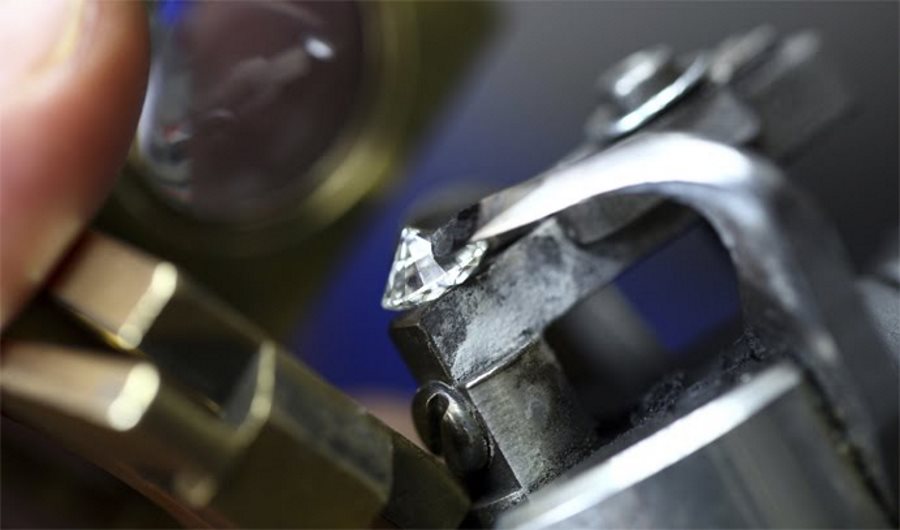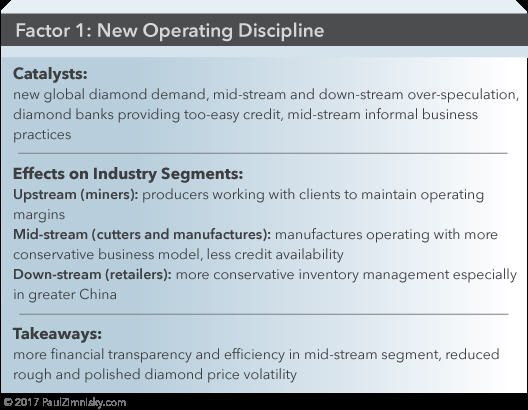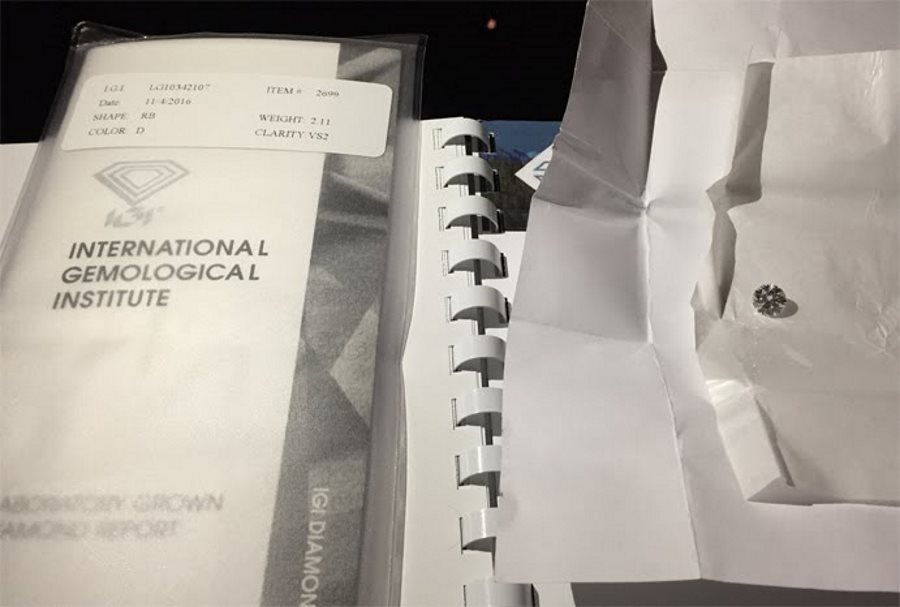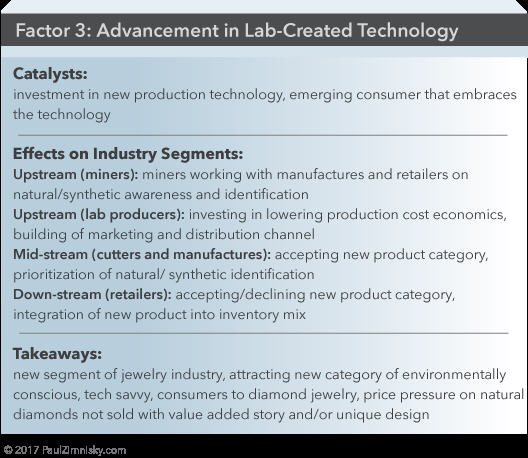A new diamond industry
From the diamond industry’s over-speculation on new consumer demand in China and India, to the resulting financial consequences and pressure on the industry to be more transparent, to shifts in generational consumer and cultural demand, and the advancement of lab-diamond production technology, the esoteric diamond industry has never been more interesting to observe and challenging to predict.
The future of the diamond industry hangs on the follow-through of structural changes that have been prompted by the challenges faced and the opportunities presented above. In recent years three primary forces have been shaping a new diamond industry: 1) a new operating discipline, 2) a new generation of consumers, and 3) new technology. All of these forces impact all of the segments of the diamond industry, from mine to retailer.

A diamond being polished. Image source: De Beers Group
A New Operating Discipline
A little over 5 years ago diamond prices reached an all-time high fueled primarily by brand new demand in the Eastern part of the world where the trend of giving diamond engagement rings in China and India was becoming a new norm. Structural economic progress in China and India generated a significant new consumer base with the ability to afford diamonds and other luxury goods, and the countries social progress exposed consumers to the engagement tradition and influence of the developed West. Chinese retainers like Chow Tai Fook (HK: 1929) began rapidly expanding throughout Greater China, with each new store opening requiring significant new diamond stock.

The assertive diamond manufacturing industry (the cutters), in an attempt to make the most of the opportunity, began buying excess rough inventory hoping to stay ahead of the inevitably rising cost curve and expand their traditionally tenuous operating margins. The banks lending to the manufactures incentivized the behavior making credit availability robust, attempting to take advantage of the opportunity themselves. The strong demand for rough, allowed the diamond producers (the miners) to congruently raise prices. From the low in 2009, post global financial crisis, to the spring of 2011, rough diamond prices rose almost 75% to an all-time high on an average price-per-carat basis.
 Chinese end-consumer demand, while growing sharply, was not strong enough to meet the over-speculation of the industry, and the heavily levered diamond manufacturing industry was forced to take loses and curb rough buying. From the high in 2011, rough diamond prices retreated by almost 20% in 2012.
Chinese end-consumer demand, while growing sharply, was not strong enough to meet the over-speculation of the industry, and the heavily levered diamond manufacturing industry was forced to take loses and curb rough buying. From the high in 2011, rough diamond prices retreated by almost 20% in 2012.
The effect of over-speculation has changed the industry. Over 6 years later, the resulting diamond stock indigestion has just recently begun to show signs of normalization after producers like De Beers, ALROSA (RTS: ALRS), and Rio Tinto (LSE: RIO) curtailed new supply to the market. Leading industry creditors, such as ABN AMRO (Amsterdam: ABN), have pulled back financing, and other key players have left the business all together like Antwerp Diamond Band (subsidiary of KBC Bank) and Standard Chartered (LSE: STAN). Manufactures are operating more conservatively and managing less speculative inventory stocks, De Beers has required that its contracted rough-buying clients adhere to IFRS international accounting standards, and the major producers are prioritizing the importance of working with their clients to help them maintain profitability through less rigorous purchasing requirements and more client-conscious pricing.
A New Generation of Consumers

A screen shot from the DPA’s “Real Is A Diamond” ad. Image source: Diamond Producers Association
While young Chinese and Indian consumers are buying diamond engagement rings for the first time, the young demographic in the West has different spending habits, priorities, and tastes than previous generations. The 18 to 35 year old group of consumers are getting married at a later age, if at all, and they typically value uniqueness, quality, and an environmentally and ethically conscious story to accompany their jewelry –shear carat weight of their diamond jewelry is not nearly as much of a priority for the typically Millennial as it was for their parents.

This is why the recently formed Diamond Producers Association (DPA) is focusing their anticipated generic diamond marketing campaign on free-spirited young couples that may or may not get married, but share love and their own unique story of how they express love. The DPA’s debut video shows a young couple exploring an island together, enjoying each other and enjoying life. The only piece of jewelry she has on is a simple diamond pendant, no ring.
Another consumer trend worthy of note is an increase in women buying jewelry for themselves. According to a recent press release from high-end London-based auction house Bonhams (private), female buyers accounted for 28% of all jewelry bought at their auctions in 2016 which is 4% higher than 5 years ago, but more significantly, the average amount they spent doubled. This is the result of a growing trend in the amount of independent income earned by women, but also, as mentioned above, a decreasing marriage rate in the U.S. and other key markets for the industry like Japan. For reference, bridal accounts for about 50% of Signet’s (NYSE: SIG) business, the U.S.’s largest jeweler, and about 1/3 of the more globally-diversified Tiffany (NYSE: TIF).
Both instances point towards demand growth trends that are more geared towards unique jewelry that has a brand, a story, and a meaning attached to it –as opposed to jewelry highlighted by a large, generic solitaire “rock,” as the industry has traditionally been primarily associated with.
The diamond industry is adjusting accordingly. The idea of attaching a story that includes a diamond’s journey from mine-to-consumer is being embraced by manufactures and retailers. By including a diamonds provenance, consumer concerns related to ethical souring and assurance that the stone is in fact a legitimate natural diamond, and not a synthetic or simulant, are also alleviated.
Signet’s Jared line recently launched a new diamond branded as “Chosen” that includes a story of the diamond’s journey, as the company conveys: “with Chosen, your diamond’s journey to you becomes part of your journey together.” Even Greater China’s Chow Tai Fook recently launched a “4 T’s” branding campaign aimed at communicating their diamonds as: “Traceable, Transparent, Truthful, and Thoughtful.”
Advancement in Lab Production Technology
Lab created, or synthetic diamonds, have been around for over a half-century, but production has only been economic for non-jewelry application until recently. Over 95% of industrial diamonds used for abrasive purposes are created in labs, most of which are produced in China and India.
Only in recent years has the diamond industry seen significant investment in gem-quality synthetic production technology aimed for use in jewelry. Companies such as St. Petersburg Russia’s, New Diamond Technology (private), is producing high quality diamonds for jewelry usage but only as a stepping stone as they develop more economic processes for producing diamonds for higher-margin high-tech application.
The challenge with the synthetic diamond jewelry business plan is not only does a company need to develop a technology capable of producing gem-quality diamonds economically enough to offer their product at a significant discount to the natural equivalent, but a brand and distribution strategy to accompany the new product also needs to be developed, which can be extremely costly.

A 2 carat+ lab-created diamond produced by New Diamond Technology. Image source:
Success in the jewelry, and the luxury business in general, has historically been highly dependent on branding and marketing given the emotional association tied a non-essential discretionary purchase. To most consumers a diamond is a diamond, and the only thing that differentiates one from another is an association in the consumers mind to a feeling tied to a commercial, song, color, logo, image, or name –Tiffany, Cartier (subsidiary of Richemont), Zales, and Kay (Zales and Kay are subsidiaries of Signet) come to mind. Creating a powerful emotional association with a lab-grown diamond is the biggest challenge to the synthetic diamond jewelry business.

All of that said, the lab-grown industry is making progress; money is being invested in technology, and company’s like The Diamond Foundry (private) have garnered a healthy amount of publicity. More consumers than ever before are aware that a synthetic diamond is a different product from cubic zirconia, white sapphire, and moissanite, the “diamond simulants.”
Lab-created diamonds will change the diamond industry as there is a customer base that will embrace the price, the technology, and/or the perceived environmentally-conscious nature. As the industry develops, the proper message that both the natural and lab-created players need to continue to communicate with consumers is that these diamonds are in fact chemically diamonds, but they can be identified as lab-grown with proper equipment, point being, they are both diamonds but inherently different, at which point a consumer can make a purchasing decision based on price and tangible and intangible value assumptions.
As the technology improves, the economics of gem-quality synthetic production will continue to improve. Relative prices will come down because the supply of natural diamonds at any given quality is fixed, but the supply of synthetics at any quality is theoretically unlimited. In the coming years, the lab-created product will garner a larger piece of the diamond jewelry market, of which now is only 1-5% according to my estimates. Synthetic diamonds current sell for only approximately a 15-20% discount, on average, to natural equivalents, where as synthetic versions of other gems like, ruby, emerald, and sapphire sell at as much as a 95% discount to natural equivalents (however, the synthesizing process for these gems is less complex).
At the time of writing Paul Zimnisky held a long covered-call position in Dominion Diamond Corp.
Paul Zimnisky is an independent diamond analyst and consultant and can be reached at www.paulzimnisky.com, and followed on Twitter @paulzimnisky
{{ commodity.name }}
{{ post.title }}
{{ post.date }}

Comments